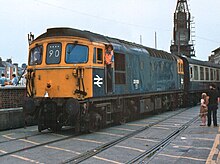Weymouth Harbour Tramway



The Weymouth Harbour Tramway (also The Quay Branch or Harbour Line) is a disused tramway running entirely on the streets of Weymouth, England from a junction to the north of Weymouth station to Weymouth Quay station at Weymouth Harbour. Built in 1865, it was last used for regular services in 1987 and for other purposes on occasions until 1999.
History
Opened in 1865 by the Great Western Railway, the harbour tramway runs from a junction beyond the main station, through the streets adjacent to the Backwater and the harbour, to the quay. Passenger trains began in 1889, transporting travellers to Channel Island ferries.
As freight traffic grew, several sidings and loops were added to the main line to serve harbourside businesses. The town bridge was rebuilt in 1930, and the tramway initially routed through the northern arch. Between 1938 and 1939 the tight curve between the Backwater and harbour was supplanted by a new curve on a newly infilled section of the quayside and the tramway was relocated to the outer arch of the bridge, where it remains today.
The track layout at the station was gradually increased from a single track, to a double track layout up to 1961, and finally a three road arrangement which persisted to the end of regular traffic, albeit in a truncated layout from 1973. Regular goods traffic ceased in 1972, though fuel oil was transported to a facility at the pier until 1983. Regular passenger services ceased in 1987.
There were some experiments in 1997 with a flywheel powered vehicle (see Parry People Movers), but this did not result in permanent traffic on the tramway. The last known use of the branch was on 30 May 1999 for a special Pathfinder Tours charter.[1]
Operations
Trains operating over public thoroughfare tramway without escort are required to be fitted with warning equipment for the general public.
During operation of services by British Rail Class 33 locomotives, two warning units were built and housed in a cabinet at the track side entrance to the tramway at the throat of Weymouth yard. This equipment comprised a yellow box which fitted on a lamp bracket on the cab front, and had an amber rotating beacon and bell which served to warn thoroughfare users. The bell did not ring continuously but could be controlled by the train driver. Each member of Class 33/1 and all TC stock had a small socket where the bell/beacon units plugged in to draw power from the train systems. Trains for the quay would halt at the station throat, the warning equipment attached and then tested by the train guard. In addition, trains on the tramway were "walked" by railway staff with flags, clearing the route of people and badly parked cars all the way between the points at which the tramway reverted to conventional track at the quay station and road crossing into Weymouth yard. On arrival at the quay terminus the guard would move the warning equipment to the other end of the train in readiness for the return journey.
The Twenty First Century
The tramway still exists, in remarkably good condition, and could in theory be used again, though the short reserved section from King Street to the junction is somewhat overgrown. In January 2009 it was reported that Weymouth and Portland Borough Council wished to remove the tramway, and that Network Rail had confirmed it had no wish for its retention.[2] In February 2009, the council agreed to purchase the line from Network Rail for £50,000, prior to a final decision on its future.[3] However it was reported in July 2014 that the sale of the line never went through and a campaign started to reopen the tram route claiming it would help with tourism and reduce car usage in the town. In august, 2015 a report appeared in the Dorset echo saying that a petition online had been set up to reopen the line.[4]
Domesday Project
The branch was included in the 1986 BBC Domesday Project; 25 years later it has been revisited and is incorporated into the reborn, online project. [5]
Gallery
|
References
- Lucking, J.H. (1986). The Weymouth Harbour Tramway, Poole: Oxford Publishing. ISBN 0-86093-304-0
- Beale, G. (2001) The Weymouth Harbour Tramway, Wild Swan Publications. ISBN 1-874103-67-4
- ^ Six Bells Junction, Way-Farer Railtour, 2 May 1999.
- ^ "Olympic train line may be lost". BBC News. 30 January 2009. Retrieved 30 January 2009.
- ^ "Train line taken over by council". BBC News. 3 February 2009. Retrieved 4 February 2009.
- ^ "Campaign to reopen Weymouth seafront train line". BBC News. 3 July 2014. Retrieved 3 July 2014.
- ^ "Revisiting the old Weymouth Quay railway". BBC News. 16 May 2011. Retrieved 17 May 2011.
External links
- BBC News story includes vintage film of the tramway in operation
- Tramway Meeting August 08
- Photos of a visiting railtour in 1993
- Weymouth Quay Railway - many images taken July 1985
- Southern E-Group article about the last train to use the line in 1999
- Weymouth Quay Railway (Gear Wheels The Online Motoring Magazine)
- Virtual Cab Ride along the tramway, or quay line
- Multimap view of the tramway
- Article about Melcombe Regis station on the nearby Portland Branch which includes a vintage map of the tramway
Video
- Operational footage of the Boat train, June 1987
- Train akes it way alog the tramway, with novel methods used to remove fouling vehicles
- Last train to use the line, 1999










